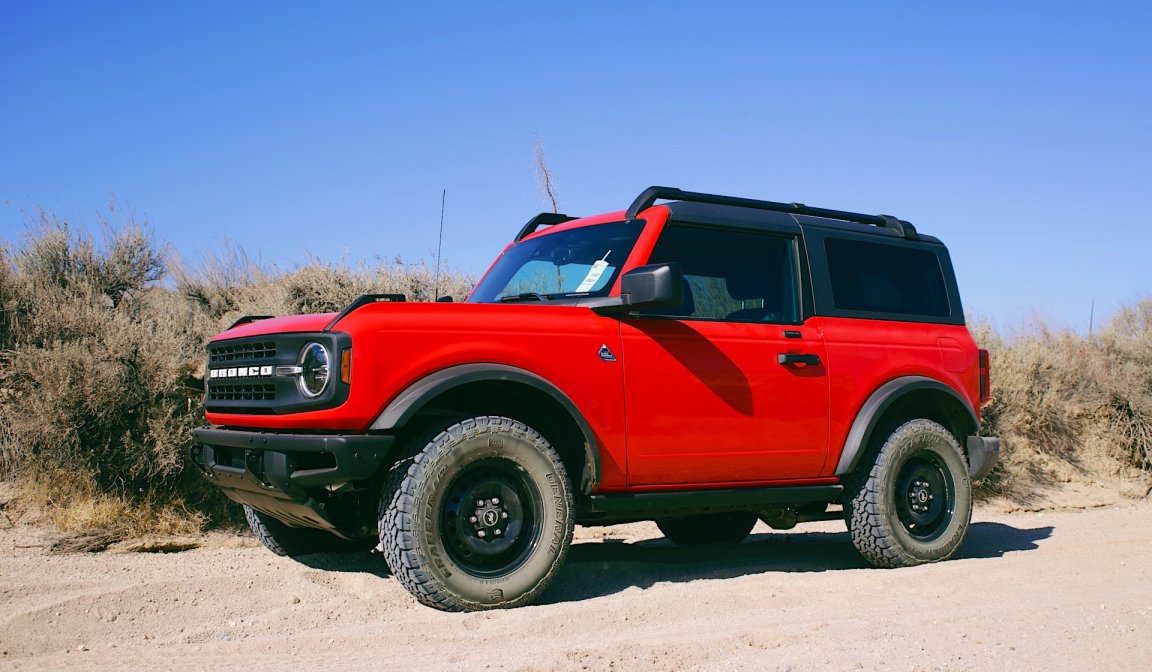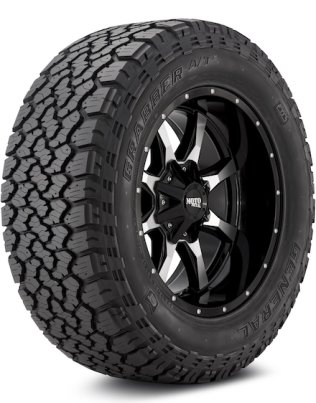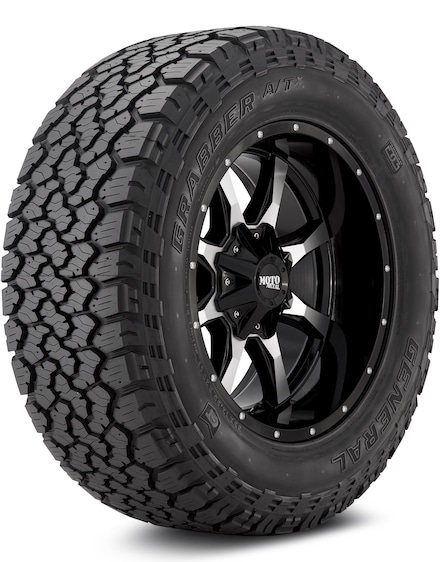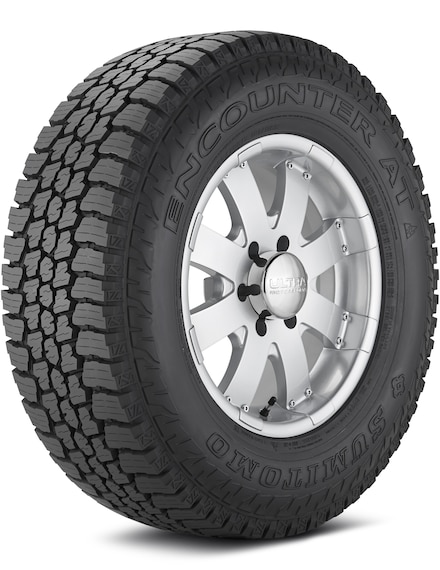We may earn revenue from the products available on this page and participate in affiliate programs. Learn more ›

When you buy a vehicle with looks that suggest off-road performance, you need to make sure the tires you choose can back up the promises those looks are making. Enter the all-terrain tire, which splits the difference between purpose-built (but noisy) mud-terrain tires, and the comfort-oriented all-season tires many vehicles come equipped with. Nor are these dedicated snow tires, but represent a nice middle ground in capability while giving vehicles the ability to stay surefooted in most off-road situations.
All-terrain tires are a popular choice for light trucks, SUVs, crossovers, or basically anything with four-wheel drive. While many tires are equipped with the M+S rating, many newer tires come branded with the Three-Peak Mountain Snowflake symbol, a rating based on performance, not just design. We’ve created this guide to help you consider the wide range of tires available and to give you recommendations for some of the best all-terrain tires on the market.
Summary List
- Best Overall: BFGoodrich All-Terrain T/A KO2
- Best Value: General Grabber A/TX
- Honorable Mention: Kumho Road Venture AT51
- Best for Trucks: Pirelli Scorpion All-Terrain Plus
- Best for Snow: Cooper Discoverer AT3 4S
- Best for Highways: Firestone Destination A/T2
- Best for Daily Driving: Sumitomo Encounter AT
- Best 35-Inch: Cooper Discoverer STT Pro
Our Methodology
To choose the best all-terrain tires on the market, we employed a comprehensive research methodology. We evaluated dozens of tires before choosing the top contenders. Although we haven’t personally tested all of these products, our selection is informed by consumer testimonials, expert reviews, discussions on relevant online forums, and our institutional knowledge of the automotive industry.
Though there’s a wide range of tires rated with the M+S designation, for “Mud and Snow” we found the designation was not tied to any performance criteria, but rather to a design style. Stepping up from the basic design designation are tires rated to the Three-Peak Mountain Snowflake (3PMSF) which requires tires to pass a performance acceleration test on medium-packed snow. All things considered, the all-terrain tire is notably not a dedicated winter tire, but narrowing our criteria to include the 3PMSF rating gives us confidence these tires will keep drivers going in all but the most extreme conditions.
Some brands are already well-established in this niche, and priority was given to their products. However, other lesser-known brands were also evaluated. The main features taken into consideration were price, off-road performance, treadwear, winter/snow performance, and ride quality/noise.
For this guide, we picked an imaginary test vehicle: a 2018 Ford F-150 with 4WD, with 265/70-17 tires. All prices and weights are in relation to that dimension but should translate across the segment.
Best All-Terrain Tires Reviews & Recommendations
Best Overall
BFGoodrich All-Terrain T/A KO2
See ItPros
- CoreGard technology—split/bruise resistant sidewalls
- 50,000-mile warranty
- Serrated shoulder design for mud/snow/rock traction
Cons
- Ride comfort trade-off compared to competition
- More on-road noise than competition
Best Value
General Grabber A/TX
See ItPros
- Treads made of cut- and chip-resistant compound
- Deep, angled treads help in loose terrain
- Can be studded for additional traction
Cons
- Performance suffers on wet roads
Honorable Mention
Kumho Road Venture AT51
See ItPros
- Good feel and performance in range of conditions
- Road noise is not excessive
- Low price for non-LT tires
Cons
- Lower treadwear rating than the competition
- Durability question likely linked to cheaper non-LT tires
Best for Trucks
Pirelli Scorpion All-Terrain Plus
See ItPros
- Capability without the over-the-top “off-road”
- Available in LT for higher load range
- Quiet ride on pavemen
Cons
- LT tires are more expensive
- Ride quality over broken pavement poor
- Some users report accelerated tire wear
Best for Snow
Cooper Discoverer AT3 4S
See ItPros
- Silica-based tread compound increases grip
- Aqua Vac Channels help resist hydroplaning
- Most recommended to friends in Tire Rack’s ratings
Cons
- Road noise
- Can be pricey
Best for Highways
Firestone Destination A/T2
See ItPros
- Solid all-around performer
- Downright astounding life from some users
- As pleasant on-road as it is off
Cons
- Pricey—nearly T/A KO2 money
Best for Daily Driving
Sumitomo Encounter AT
See ItPros
- Great in rain
- Good on-center feel
- Generous warrant
Cons
- Some commenters noted noticeable road noise
Best 35-Inch
Cooper Discoverer STT Pro
See ItPros
- Excellent mud and rock performance
- Look amazingly aggressive
- Great in deep snow
Cons
- Likely requires supporting modifications on most vehicles
- Noticeably louder on-road
- Not rated for 3PMSF standard
Our Verdict on All-Terrain Tires
The BFGoodrich All-Terrain T/A KO2 is the best overall all-terrain tire. These are tried-and-true all-terrain tires, and they have the reputation they deserve as the best in the business. But, if you want all-terrain tires that can get you through just about anything without hitting the bank so hard, then take a look at our value pick, the General Grabber A/TX.
FAQs
You’ve got questions. The Drive has answers!
A: All-terrain tires work to provide traction on all types of weather conditions on- and off-road, across snow, rain, ice, and other adverse conditions. It is a good compromise between mud tires for off-roading ability and highway tires for general comfort, good on light trucks, full-size pickups, and SUVs. Some hallmarks of all-terrain tires include off-shoulder tread blocks, long-link carbon/steel belt construction for puncture resistance, wide tread grooves for traction, and spiral-wrapped shoulder seams to maintain a tire’s shape.
A: Tires in the all-terrain segment can set you back a healthy sum, but they’re often worth shelling out for. Almost $70 each separates our most expensive pick, the BFGoodrich All-Terrain T/A KO2, from our best value pick, the General Grabber A/TX. Many of the tires in between offer a different mix of performance and trade-offs, which is fitting for the category. Be prepared to shell out more for all-terrain tires than the bargain all-seasons on sale. Though, if you choose to wander into 35-inch (and larger!) territory, you had better sit down before you get the bill.
A: Check your tire pressure regularly. We suggest before long trips to check on each tire. Spring for a decent tire pressure gauge for the best accuracy.
Rotate your tires regularly, because the tread will wear down unevenly if you don’t. We suggest aiming to rotate tires every 6,000 miles or so, but try not to push it past 8,000 miles.
Keep an eye on tread depth. Use a tread depth gauge or penny to measure wear.
Don’t exceed the load capacity! Some all-terrain tires are built for capability and sacrifice some load-carrying capacity.
A: Tread Design: Tread-design options are virtually limitless, each rib and shoulder block pattern intended to bring key benefits when it comes to improved tread life, weight distribution, tear/puncture resistance, load-carrying capacity, and more. We favored a combination of wide shoulder lugs for traction, angled shoulders, carbon-reinforced construction for wear resistance, and heavy-duty three-ply sidewalls over traditional two-ply sidewalls for overall toughness. Unfortunately, many cheaper all-terrain tires have rightfully earned a reputation for the drone associated with lifted trucks. On mud-terrain tires, or the cheapest all-terrain tires, that’s the sound of the wind running over the larger tire’s more rugged surface, which increases with speed.
Ratings: Look for all-terrain tires with mud and snow ratings such as the Three-Peak Mountain Snowflake (3PMSF) symbol. These distinctions vouch for an all-terrain tire’s ability to ride well in muddy and snowy environments with an increased number of sipes and softer treads for better handling.
Tread Life: Expect your average all-terrain tire to last for roughly 40,000 miles. In some cases, it can exceed 60,000 miles depending on road conditions. Many all-terrain tires come with longer treadwear warranties. In general, the longer the treadwear warranty (e.g. 60,000+ miles) the harder the tread. Softer tread all-terrain tires tend to wear out a lot quicker.
A: Passenger: A number of our choices are available in a Passenger or Light Truck (LT) rating, which is more than just the load rating difference. The P-rated tires are often more comfortable on the road while remaining equally capable off the road. These tires are most frequently found on crossovers, light SUVs, and light trucks. Be careful when shopping, however, as the passenger versions of the same tire are often significantly less expensive than the LT tire
.
Light Truck: The Light Truck (LT) versions of all-terrain tires are made to take heavier loads without sacrificing off-road capability. The LT version of these tires often has stiffer sidewalls, leading to a noticeably worse ride. Like the rest of the all-terrain segment, it’s a game of trade-offs. If you need the payload or towing capacity of your vehicle to remain intact, while adding more traction in adverse conditions, then be prepared to spring for the heavy-duty LT version.
A: Yes, all-terrain tires are designed to be used all year. They work equally well on the road and off.
A: It depends on the driving environment. All-season tires are better designed to limit road noise and glide well on the highway. All-terrain tires have specialized construction (such as open tread and shoulder grooves) that make them work better on rougher terrain with improved grip and traction.
A: Look for the following signs of defective wear with your all-terrain tires before deciding to keep them or replace them:
-Shallow and unevenly worn tread.
-Damaged valve stems.
-Rougher ride than usual.
-Excessive vibration on dry and wet surfaces.
A: Tire tread depth is an excellent indicator of how worn out your all-terrain tire is. To check for tire tread depth, insert a penny into several of your tire’s grooves. If you can see all of Abraham Lincoln’s head, then your tread depth is below 2/32-inch, which is the minimum. For deeper treads, we recommend using a certified tire-tread gauge. Always refer to the manufacturer for tire-tread depth guidance.










